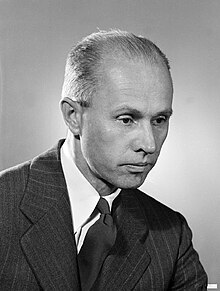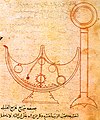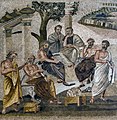Portal:History of science
The History of Science Portal
The history of science covers the development of science from ancient times to the present. It encompasses all three major branches of science: natural, social, and formal. Protoscience, early sciences, and natural philosophies such as alchemy and astrology during the Bronze Age, Iron Age, classical antiquity, and the Middle Ages declined during the early modern period after the establishment of formal disciplines of science in the Age of Enlightenment.
Science's earliest roots can be traced to Ancient Egypt and Mesopotamia around 3000 to 1200 BCE. These civilizations' contributions to mathematics, astronomy, and medicine influenced later Greek natural philosophy of classical antiquity, wherein formal attempts were made to provide explanations of events in the physical world based on natural causes. After the fall of the Western Roman Empire, knowledge of Greek conceptions of the world deteriorated in Latin-speaking Western Europe during the early centuries (400 to 1000 CE) of the Middle Ages, but continued to thrive in the Greek-speaking Byzantine Empire. Aided by translations of Greek texts, the Hellenistic worldview was preserved and absorbed into the Arabic-speaking Muslim world during the Islamic Golden Age. The recovery and assimilation of Greek works and Islamic inquiries into Western Europe from the 10th to 13th century revived the learning of natural philosophy in the West. Traditions of early science were also developed in ancient India and separately in ancient China, the Chinese model having influenced Vietnam, Korea and Japan before Western exploration. Among the Pre-Columbian peoples of Mesoamerica, the Zapotec civilization established their first known traditions of astronomy and mathematics for producing calendars, followed by other civilizations such as the Maya.
Natural philosophy was transformed during the Scientific Revolution in 16th- to 17th-century Europe, as new ideas and discoveries departed from previous Greek conceptions and traditions. The New Science that emerged was more mechanistic in its worldview, more integrated with mathematics, and more reliable and open as its knowledge was based on a newly defined scientific method. More "revolutions" in subsequent centuries soon followed. The chemical revolution of the 18th century, for instance, introduced new quantitative methods and measurements for chemistry. In the 19th century, new perspectives regarding the conservation of energy, age of Earth, and evolution came into focus. And in the 20th century, new discoveries in genetics and physics laid the foundations for new sub disciplines such as molecular biology and particle physics. Moreover, industrial and military concerns as well as the increasing complexity of new research endeavors ushered in the era of "big science," particularly after World War II. (Full article...)
Selected article -

The history of timekeeping devices dates back to when ancient civilizations first observed astronomical bodies as they moved across the sky. Devices and methods for keeping time have gradually improved through a series of new inventions, starting with measuring time by continuous processes, such as the flow of liquid in water clocks, to mechanical clocks, and eventually repetitive, oscillatory processes, such as the swing of pendulums. Oscillating timekeepers are used in modern timepieces.
Sundials and water clocks were first used in ancient Egypt c. 1200 BC (or equally acceptable BCE) and later by the Babylonians, the Greeks and the Chinese. Incense clocks were being used in China by the 6th century. In the medieval period, Islamic water clocks were unrivalled in their sophistication until the mid-14th century. The hourglass, invented in Europe, was one of the few reliable methods of measuring time at sea. (Full article...)
Selected image

Charles Darwin has been caricatured as a monkey innumerable times since the publications of Origin of Species and Descent of Man.
Did you know
...that Einstein's famous letter to FDR about the possibility of an atomic bomb was actually written by Leó Szilárd?
...that geology was transformed in the latter part of the 20th century after widespread acceptance of plate tectonics?
...that the idea of biological evolution dates to the ancient world?
Selected Biography -
George Bogdanovich Kistiakowsky (Russian: Георгий Богданович Кистяковский, Ukrainian: Георгій Богданович Кістяківський, romanized: Heorhii Bohdanovych Kistiakivskyi; December 1 [O.S. November 18] 1900 – December 7, 1982) was a Ukrainian-American physical chemistry professor at Harvard who participated in the Manhattan Project and later served as President Dwight D. Eisenhower's Science Advisor.
Born in Boyarka in the old Russian Empire, into "an old Ukrainian Cossack family which was part of the intellectual elite in pre-revolutionary Russia", Kistiakowsky fled his homeland during the Russian Civil War. He made his way to Germany, where he earned his PhD in physical chemistry under the supervision of Max Bodenstein at the University of Berlin. He emigrated to the United States in 1926, where he joined the faculty of Harvard University in 1930, and became a citizen in 1933. (Full article...)
Selected anniversaries
- 1656 – Death of Jean-Baptiste Morin, French scientist (b. 1583)
- 1771 – Death of John Bevis, English physician and astronomer (b. 1695)
- 1822 – Death of Claude Louis Berthollet, French chemist (b. 1748)
- 1944 – Plutonium is first produced at the Hanford Atomic Facility and subsequently used in the Fat Man Atomic bomb dropped on Nagasaki, Japan
- 1950 – Birth of Amir Aczel, lecturer in mathematics
- 1964 – Death of Hans von Euler-Chelpin, German-born chemist, Nobel Prize laureate (b. 1863)
Related portals
Topics
General images
Subcategories
Things you can do
Help out by participating in the History of Science Wikiproject (which also coordinates the histories of medicine, technology and philosophy of science) or join the discussion.
Associated Wikimedia
The following Wikimedia Foundation sister projects provide more on this subject:
-
Commons
Free media repository -
Wikibooks
Free textbooks and manuals -
Wikidata
Free knowledge base -
Wikinews
Free-content news -
Wikiquote
Collection of quotations -
Wikisource
Free-content library -
Wikiversity
Free learning tools -
Wiktionary
Dictionary and thesaurus









































































